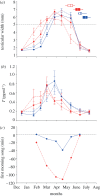Artificial light at night advances avian reproductive physiology
- PMID: 23407836
- PMCID: PMC3574380
- DOI: 10.1098/rspb.2012.3017
Artificial light at night advances avian reproductive physiology
Abstract
Artificial light at night is a rapidly increasing phenomenon and it is presumed to have global implications. Light at night has been associated with health problems in humans as a consequence of altered biological rhythms. Effects on wild animals have been less investigated, but light at night has often been assumed to affect seasonal cycles of urban dwellers. Using light loggers attached to free-living European blackbirds (Turdus merula), we first measured light intensity at night which forest and city birds are subjected to in the wild. Then we used these measurements to test for the effect of light at night on timing of reproductive physiology. Captive city and forest blackbirds were exposed to either dark nights or very low light intensities at night (0.3 lux). Birds exposed to light at night developed their reproductive system up to one month earlier, and also moulted earlier, than birds kept under dark nights. Furthermore, city birds responded differently than forest individuals to the light at night treatment, suggesting that urbanization can alter the physiological phenotype of songbirds. Our results emphasize the impact of human-induced lighting on the ecology of millions of animals living in cities and call for an understanding of the fitness consequences of light pollution.
Figures


References
-
- Grimm NB, Faeth SH, Golubiewski NE, Redman CL, Wu J, Bai X, Briggs JM. 2008. Global change and the ecology of cities. Science 319, 756–76010.1126/science.1150195 (doi:10.1126/science.1150195) - DOI - DOI - PubMed
-
- McKinney ML. 2006. Urbanization as a major cause of biotic homogenization. Biol. Conserv. 127, 247–26010.1016/j.biocon.2005.09.005 (doi:10.1016/j.biocon.2005.09.005) - DOI - DOI
-
- Shochat E, Warren PS, Faeth SH, McIntyre NE, Hope D. 2006. From patterns to emerging processes in mechanistic urban ecology. Trends Ecol. Evol. 21, 186–19110.1016/j.tree.2005.11.019 (doi:10.1016/j.tree.2005.11.019) - DOI - DOI - PubMed
-
- Partecke J, Van't Hof TJ, Gwinner E. 2004. Differences in the timing of reproduction between urban and forest European blackbirds (Turdus merula): result of phenotypic flexibility or genetic differences? Proc. R. Soc. Lond. B 271, 1995–200110.1098/rspb.2004.2821 (doi:10.1098/rspb.2004.2821) - DOI - DOI - PMC - PubMed
-
- Partecke J, Schwabl I, Gwinner E. 2006. Stress and the city: urbanization and its effects on the stress physiology in European blackbirds. Ecology 87, 1945–195210.1890/0012-9658(2006)87[1945:SATCUA]2.0.CO;2 (doi:10.1890/0012-9658(2006)87[1945:SATCUA]2.0.CO;2) - DOI - DOI - PubMed
Publication types
MeSH terms
Substances
LinkOut - more resources
Full Text Sources
Other Literature Sources
Miscellaneous
